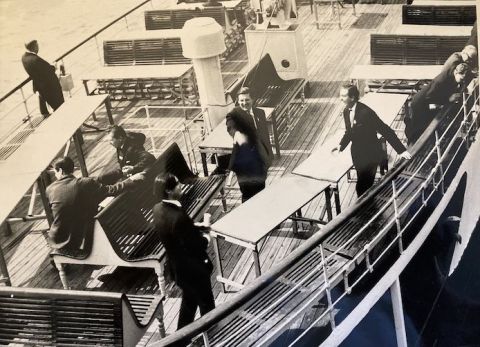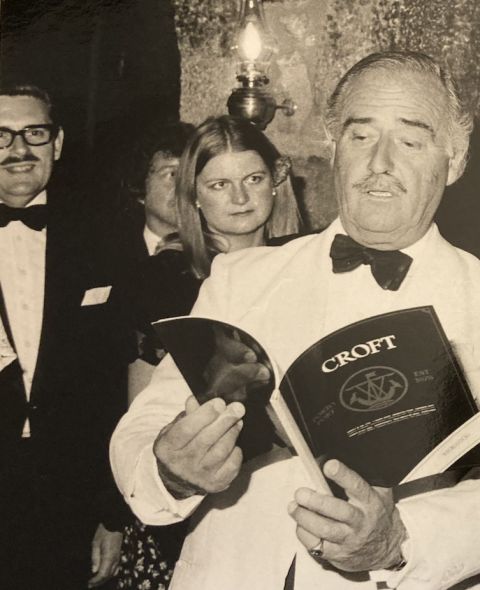George Bull, in his own words, ‘had no difficulty whatsoever in leading from the front’. This charismatic former Coldstream Guards officer combined a formidable presence with the strongest loyalty to his causes. Leading by personality rather than any pretence of intellect was his trademark and we all loved him the more for it.
In the world of wines and spirits in the 1960s, it certainly helped if you ‘knew someone’ or had been to a public school. George’s mother was a Hennessy and he had been to Ampleforth. He was thus part of the family links that created the iconic International Distillers and Vintners (IDV) in 1962. IDV, elegantly housed in a luxurious Nash building, 1 York Gate by Regent’s Park, became a byword for style, friendship and innovation. In other words, the envy of our wine-merchant competitors.
Its national and international portfolio included an array of fine brands such as J&B whisky, Gilbey’s gin, Smirnoff vodka, Hennessy cognac, Croft port, and Château Loudenne in the Médoc. IDV went on to launch such stellar brands as Bailey’s Irish Cream, Malibu and Le Piat d’Or [the wine, IDV rather mischievously claimed, the French ‘adored’ – JR].
George, via a short stint at Dorland advertising agency, cut his teeth in the drinks trade by helping to export Heidsieck Dry Monopole champagne within the Hennessy distribution division. In 1967 he was promoted to a new internal position, marketing manager of IDV home trade.
Today this appointment would go unnoticed. Back then, it was revolutionary, or more accurately, evolutionary. Back then, marketing simply did not exist in our somewhat gentlemanly business. You produced or bought, then you sold.
George’s new marketing department brought a whole new dimension to our trade. I got the call, out of the blue, to join this new enterprise in 1968. A few proper marketers had just joined. A few others joined with me.
Our main task was to produce a ‘marketing appreciation’ followed by a three-year marketing plan for each brand, which we then discussed with the principal or brand owner mainly to get them to contribute, as significantly as we could, to the annual marketing budget.
George, never losing his military bearing, also had absolutely no difficulty in delegating. ‘It’s your plan, you run it.’ With internal discussions it was business as normal, but on one outing together to the 16th century Bols distillery in the Netherlands, we soon discovered that this was the first marketing plan they had ever seen in almost 400 years of trading their advocaat and genever gin. Somewhat bemused, they bought into it.
Gin was big in those days; vodka had only just arrived in the UK. Gilbey’s gin, courtesy of the Gilbey family, one of the founding families of IDV, was big internationally, but needed a reboot in the UK. A mighty PR coup was planned to convert an Isle of Wight paddle steamer into a floating Gilbey’s gin palace on the River Thames (George in command in the centre of the picture below). Thinking outside the box.
Totally focused, encouraging these quirky ideas, George initiated and presided over our annual marketing conferences. These were designed to sell our marketing and PR ‘routes to market’ to the UK sales forces. The venues varied, but his clear leadership, then and later, helped turn our collegiate trade into an internationally respected industry. We had fun; we thought we worked hard; we achieved.
George had the advantage of a very clear, resounding voice which never seemed to falter. His elegant, pin-striped suits clothed a most remarkable and friendly human being who knew how to get the best out of us all. Supported by his delightful wife Tessa, he was very much a family man and that sense of caring showed through.
Early on, George invited us young brand managers to dinner at his Wimbledon home where we first met Tessa. Ever smiling, she welcomed us in as ‘George’s bright young things’.
Apart from marketing existing wine and spirit brands, the genius difference between IDV and other UK wine merchants was that IDV was arguably the first such company to consciously create whole new categories of drinks. Using solid US dollars flowing in from the highly successful J&B whisky brand in the USA and engaging with leading advertising agencies in London, IDV was test-launching new brands on almost a monthly basis.
Bailey’s was created as a light, after-dinner liqueur to replicate the success of After Eight chocolates. Early-morning visits to Covent Garden market ensured that the team were aware of which fruits were trending and could be used in flavouring spirits. New brands of table wine such as Docura, which flopped, and Le Piat d’Or, which succeeded, were based on consumer preferences rather than producers’ traditional ways.
Having created a strong marketing base in the industry with the accompanying financial and brand disciplines, George rose peerlessly through the ranks, officer ranks of course, to head up in succession IDV Home Trade, the IDV group, then as it became Grand Met and finally Diageo.
After Diageo he joined supermarket Sainsbury’s, which I have a feeling he did not enjoy quite so much as his alma mater, the IDV fountain that so consistently gushed forth that it became the basis of one of the world’s largest drinks groups.
His was a hugely successful business career, by any standards. He was knighted, ‘for services to the alcoholic drinks industry’, in 1998.
None of us ‘young things’ who were based at York Gate during those early years, either in the marketing department or in export, will ever forget George’s friendship, his leadership style, his charisma and his devoted wife Tessa, who died last year.
In later years, at our regular trade lunches and dinners, most often at the Pickwick Club in London, George, then in his eighties, still regaled us all, at full volume and at length, with wit, surprise and good conversation. He inspired us to enjoy our own career paths. He was always there. He will be much missed.
















